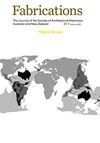A Journey to the Experimental Nation: Henry Demarest Lloyd and the Search for Industrial Democracy in New Zealand
IF 0.3
0 ARCHITECTURE
Fabrications-The Journal of the Society of Architectural Historians Australia and New Zealand
Pub Date : 2020-09-01
DOI:10.1080/10331867.2020.1827551
引用次数: 0
Abstract
ABSTRACT In 1899 the American journalist Henry Demarest Lloyd was one of many social reformers who travelled to New Zealand to witness the social programmes instituted by the Liberal government. For Lloyd and other Progressives, New Zealand represented a model industrial democracy. His book Newest England (1900) describes Public Works Department projects built under the direction of the Department’s Minister, Richard Seddon, including the Makōhine Railway Viaduct. This viaduct was significant as the first steel structure built using the cooperative labour system. This paper places Lloyd’s interpretation of the Makōhine Viaduct within the Progressive discourse about design and labour taking place in Chicago around 1900, focusing on the activities of the Chicago Arts and Crafts Society of which Lloyd was a member. Attention to Lloyd’s Newest England reveals a radical plan for the future of industrial society, one that prefigured the technocracy movement of the early twentieth century. In its dedication to the aims of settler colonialism, it also reveals the theme of racial evolution underpinning Progressive visions of the coming industrial democracy. Exploring that theme, the paper expands scholarship on the origins of modern American architecture in Chicago to include the historical context of colonisation and global immigration.《实验性国家之旅:亨利·德马雷斯特·劳埃德与新西兰工业民主的探索》
1899年,美国记者亨利·德马雷斯特·劳埃德(Henry Demarest Lloyd)作为众多社会改革家之一,前往新西兰见证自由党政府制定的社会计划。对劳埃德和其他进步人士来说,新西兰代表了一个工业民主的典范。他的著作《最新的英格兰》(1900)描述了公共工程部在部长理查德·塞登(Richard Seddon)的指导下建造的项目,包括Makōhine铁路高架桥。这座高架桥是第一座使用合作劳动制度建造的钢结构,意义重大。本文将劳埃德对Makōhine高架桥的解释置于1900年左右发生在芝加哥的关于设计和劳动的进步话语中,重点关注劳埃德是其成员的芝加哥工艺美术协会的活动。关注劳合社的《最新的英格兰》揭示了工业社会未来的激进计划,它预示着20世纪初的技术官僚运动。在致力于定居者殖民主义的目标时,它也揭示了种族进化的主题,支撑着即将到来的工业民主的进步愿景。探索这一主题,论文扩展了芝加哥现代美国建筑起源的学术研究,包括殖民和全球移民的历史背景。
本文章由计算机程序翻译,如有差异,请以英文原文为准。
求助全文
约1分钟内获得全文
求助全文
来源期刊

CiteScore
0.50
自引率
25.00%
发文量
26
 求助内容:
求助内容: 应助结果提醒方式:
应助结果提醒方式:


